#thanks for the tags tho
Explore tagged Tumblr posts
Text

Charles “We’ve got literally forever to figure out what the rest means” Rowland
#what in gods name is their ship name#someone make a poll so we can vote and figure it out please and thank you#dead boy detectives#charles rowland#edwin payne#paynland#I’m not tagging chedwin because that’s awful#tho my issue with paynland is people are gonna get confused if it’s payneland or paynland#whatever#payneland#they are so important to me#I love how romantic love isn’t shown askre important than platonic#devoted if the best way to describe their relationship
6K notes
·
View notes
Text
I wanna participate in all this tag games but I have no idea how you edit the templates so I’m just sat there like 👍🏾
#I feel like a boomer#thanks for the tags tho#also I need to make more mutuals but I don’t even know where to start from#ok bye
0 notes
Text






class swap design masterpost for convenience (from top to bottom: bard!riz, cleric!gorgug, sorcerer!kristen, barbarian!fig, artificer!adaine, and rogue!fabian)
#dimension 20#fantasy high#fhfy#fhsy#fhjy#riz gukgak#gorgug thistlespring#kristen applebees#figueroth faeth#adaine abernant#fabian seacaster#my class swap stuff! oh yeah I think I got a tag for that I'll call that#fh class quangle#gna slowly go back and get that tag on relevant posts too. for organization's sake#even tho I didnt really intend this blog to be that kinda blog lmao. we were all just gonna be out here dealin with that at our own pace#anyways uh! they! u know all the lore for the designs already I put em in tags. but otherwise this also collects like the#color keys kind of for these. mostly the things that change between designs#doing this did make me realise half of these are a Lot more consistent in color keys than the other half lol#like kristen's palette stays pretty much the same. and fabian's. the hit's mostly in the construction#a lot of this is overall like an exercise in remembering what high schoolers would actually wear and how to work in Costume pieces#on this point at least I straight up have No relevant recollection lmao all the basic education establishments I went to have uniforms#and outside of school I was. well kind of a shorts and tee guy. so#on that topic I feel like fabian's is the furthest stretch lmao. like if a guy in high school wears the same bright yellow raincoat#to school every day that's like. people would Not like that guy. fabian really is saved by being cute and a rogue#he will still have stans when he's deep in his fishing arc in junior year he's the manic pixie dream bf#anyways uh. things to do! stuff to get done. sleep first tho. have a good night lads#I have not caught new nsbu yet! seems I mostly catch them like two to three days late nowadays.#so please uhh. don't reply on my posts with nsbu spoilers? we are all excited and having fun but that's rude#ok thank u. signing off for the day have a good night#!!
2K notes
·
View notes
Text
Here it comes. No audio.
*if anyone want to add audio to this, feel free too. (But please show me)
THIS POST
Because I have to.
#I can't add video to the rebloggggg#for reallll???#I need to work so I have to stop now#tf mecha universe#I absolutely can't#Can you tell I can't draw mech#cuz I can't#drawing First Aid screaming is the most satifying thing ever tho#I love this boy#Thank you keferon and SSTP for making all this good food#texaid#by the way the vortex's panic were suggested by SSTP and kef themselves#so yeah#animation tag
758 notes
·
View notes
Text

and i got eyes on the back of my head, i got eyes everywhere so i know where you go
#yrdnzz art#blue lock#blue lock fanart#isagi yoichi#isagi#bllk#artists on tumblr#hey#been a minute.... sorry fazgang#I FEEL LIKE IM ALWAYS APOLOGIZING IN THE TAGS my fault#ill do better mb yall i just graduated this month and ive been just chilling doing fuck all bc ive been artblocked AYE EFF#big thank u to jamie for talking me thru this piece even tho its sooo simple#just having someone to talk to about how i feel abt my art was very helpful bc i was definitely stuck on how to start drawing again#what graduating with a bs in comp sci does to a mf i guess#anyways hope yall like this one LOVE U ALL MWAH
2K notes
·
View notes
Text

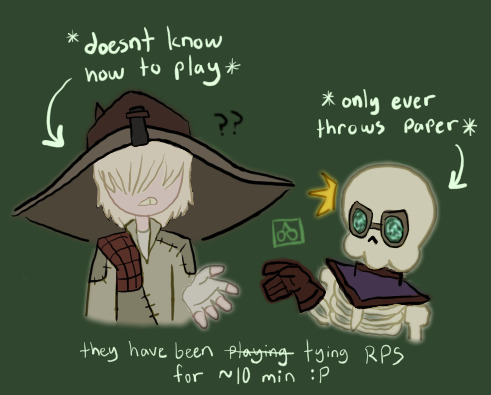

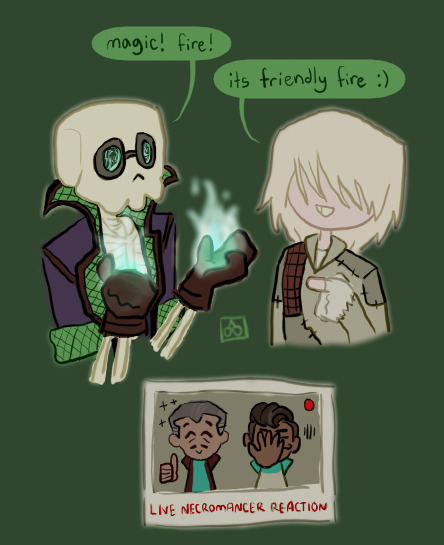
everybody was very nice on my last post(s) so !!! more cole and manfred be upon you :D
#my arts#dragon age#dragon age veilguard#dragon age the veilguard#dav#datv#da4#dragon age 4#veilguard#the veilguard#manfred dragon age#cole dragon age#dragon age manfred#dragon age cole#manfred the skeleton#cole the spirit of compassion#dragon age veilguard spoilers#emmrich volkarin#dorian pavus#EHHHH TECHNICALLY#not tagging solas or the iron bull tho. that feels cheaty#im still not very good at drawing skeletons (can you tell i was experimenting w his head lol) so take that as u will#but i loooooove doodling cole esp his hair <3 wet cat core. he used to be on so many of my school notes back in the day :]#i think i am going to draw them w some weird friends next (basically. sandal and kieran. cryptic boys my beloveds) but we will see !#also maybe something w varric bc uhhh. yeah >_>;;;#its crazy bc i know like 10 things that happen in veilguard and thats it. but fck it we ball >:3c#oh i also had an AU idea too UGH i have so much i wanna draw but ill stop#thanks for looking at my art and also i love you <33
973 notes
·
View notes
Text


More TF doodles/studies bcs I'm stubborn and want to learn to draw tfp Optimus
+ a somewhat G1 Ratchet that found his way in there LOL
#myart#maccadam#ratchet#optimus prime#tfp ratchet#tfp optimus prime#optiratch#← slight but also I'm currently rewatching tfp and yeah#i do love them#transformers#doodles#i'm in my tf phase but I'm still drawing db a lot so my acc might become a mess#thank goodness tumblr has a good tagging system unlike twt tho#TFP OPTIMUS IS A PAIN TO DRAW#transformers fanart#tfp
448 notes
·
View notes
Text

saw a couple of ppl doing these posts, so i present to you my very first attempts at drawing seb vs now.......and just looking at the old ones causes me actual physical pain😭😭 bc why does he look like hes wearing a TOUPÉE???😭 we dont talk about it....just dont go too far back in my blog im begging you
#even drawings of him from like a few weeks ago or a few months ago i already hate LMAO its a quick turnover around here folks#i was looking at old wips yesterday and i was liek EW OH GOD thank god i never finished these bc i used to think these were good#and now im redrawing them#clora still looks great tho LMAOO its always just seb i look back on and go EWW WHO ARE YOUUUU🤢🤢🤢🤢#god i cant stop staring at how i drew his hair like girl.... wtf were u looking at as a reference when u put that MOP ON HIS HEAD!!!#old seb isnt real he cant hurt you😮💨#except for the psychic damage that he causes when i look at him#im not tagging this as choccyart#more like CHOCCYFART!!!!#gottem
422 notes
·
View notes
Note
your comic of erik "kidnapping" charles is living rent free in my head... I can't stop thinking of a scenario where somebody didn't get the memo about the vacation/kidnapping thing they've got going on and bursts into erik's Evil LairTM of the week to rescue the poor professor only to be mentally scarred at finding him making out nasty style with magneto



i cant stress enough how fast i went to draw this as soon as i got the chance god help any new x-man to the team
#xmen#xmen comics#cherik#charles xavier#professor x#erik lehnsherr#magneto#im not tagging everyone else. also who's looking for mimic. hes here for me tyvm#snap sketches#this is just a part of initiation. not intentionally but it'll happen to everyone at least once#CRYINGGG thank you for this ask vejalkver#whats funny is that i thought of including mimic in another thing im drawing Hopefully soon#big week for mimic fans. all five of them#ANYWAY i gotta grocery shop with my bro soon. i told yall time is so finite where did the day go its already 1PM#morning well spent tho i tell you that !!!!!! BYE lets see if i can sketch anything else out quick
643 notes
·
View notes
Text

I don't have a title for this I just really wanted to draw this pic of lando
(og picture and a flat colour version under the cut :3)


#pondering if there would be any interest in a tag list for my art posts#school is still killing me so deffo won't be frequent tho#huge thank you to my dear husband and cube for holding my hand through this#f1#f1 fanart#ln4#lando norris#lando norris fanart#neverleft underscore#neb50#neb100#neb200#neb500#neb750
779 notes
·
View notes
Text

Commissioned piece for Missiletainn! 💞
#artists on tumblr#pokemon#larvesta#gotchibam arts#commissioned piece#thank you sm for being patient w/ me!! ;w;#was supposed to post this sooner but I recently caught the flu ._.#feeling better now tho so hopefully i'll be able to post all the finished comms soon!#also i'm very happy to know you liked it!! I saw you tag me on bsky & I appreciate the kind words! ;w; <3
400 notes
·
View notes
Text

2024 art summary! it sure has been a year
#ever makes art#i bsky tweeted a bit but it feels weird talking there still so ill do my usual rambling into tags here :)c#i burned out super bad in the middle of this year for months where it felt like i couldnt draw anything good no matter how hard i tried#and the harder i tried the worst it felt - to the degree that i legitimately thought i wasnt going to be able to draw anything again#which sounds SO dramatic i know i know. but feelings arent always rational!!! and so many others things were going wrong at the same time#so it was strange putting together this year's art summary and realizing Huh. i did still have paintings to put in every space#that fear/anxiety spiral seems even sillier and more meaningless now that i have distance and proof of how irrational it was...#...but in reflection i'd like to think of it as proof that even when you feel at your worse it's worth it to keep trying...!!#after the Black Hole of Nothing i've been working every day on never ending doujin and xv anthology and orv sketchzine and merch#i can't say that i feel my artistic skills have like. improved or anything... but the passion i feel for the stories i read and#the stories i want to tell is still there!! and the happiness from getting to put form to those feelings large or small is worth it too#anyway......... lotta words to say tho i haven't posted much anymore and socmed is imploding and the world is dark#thank you very much for staying with me another year. i am - as ever - always grateful
339 notes
·
View notes
Text
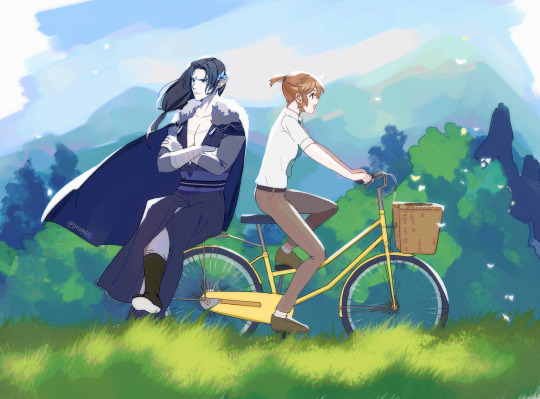


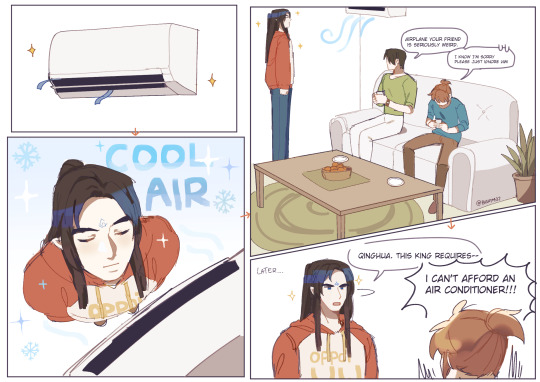
inuyasha-esque AU where moshang travel back & forth between worlds bc im stupid like that 🥴
#svsss#scum villian self saving system#moshang#mobei jun#shang qinghua#shen yuan#shen qingqiu#if u copy my tags pls prev me thanks 🙏 —op#college professor!sqh stumbling across ancient magic and getting transported into mbj's world IDK something like that#im obsessed with mbj being obsessed with the glorious aircon#and also him wearing the oppai hoodie#lbh would actually be perfect for this tho bc hes literally a half demon sskkssk#fck it after this i’m gonna draw mbj lbh and nmj in the oppai hoodie im a genius#mine#mxtx
3K notes
·
View notes
Text

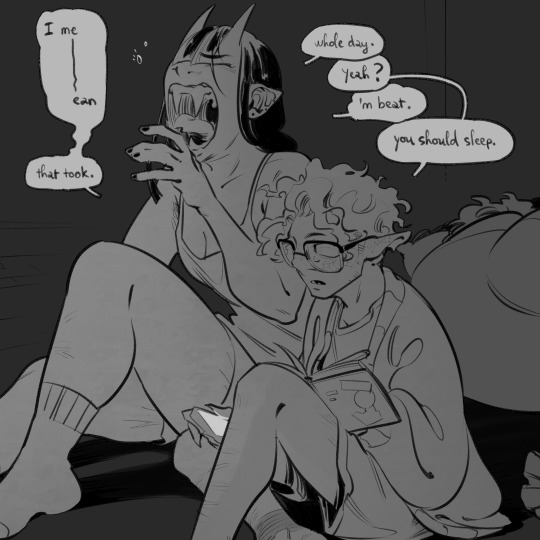
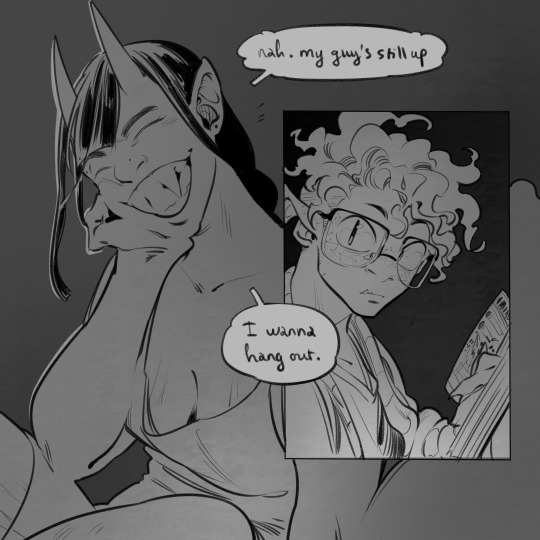
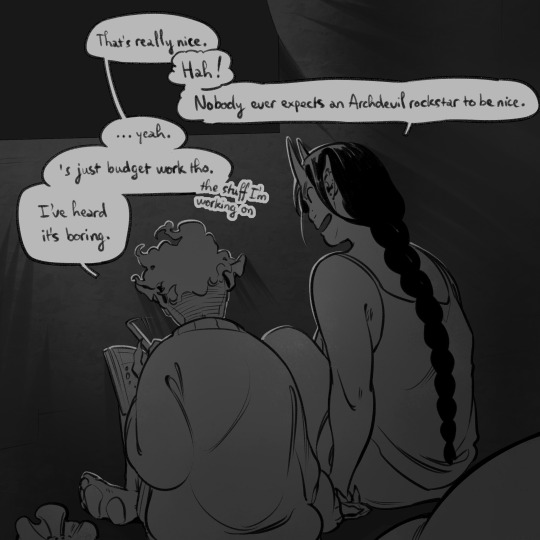
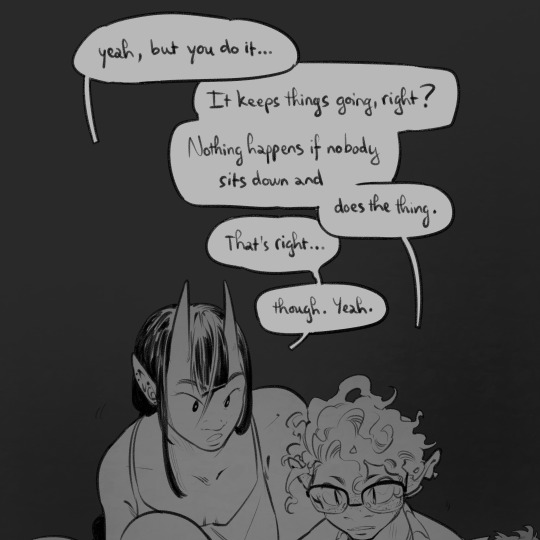


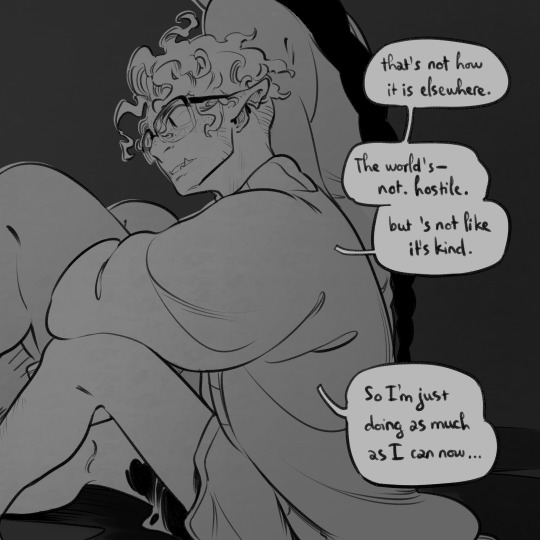
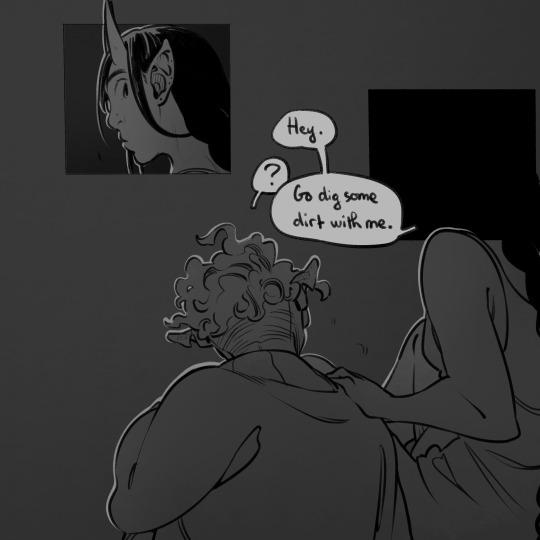

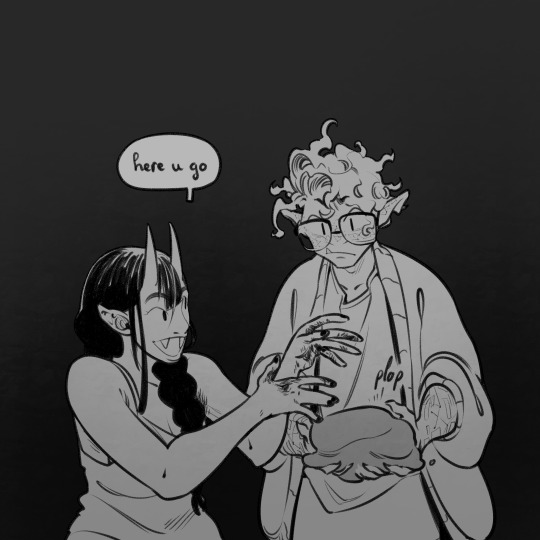

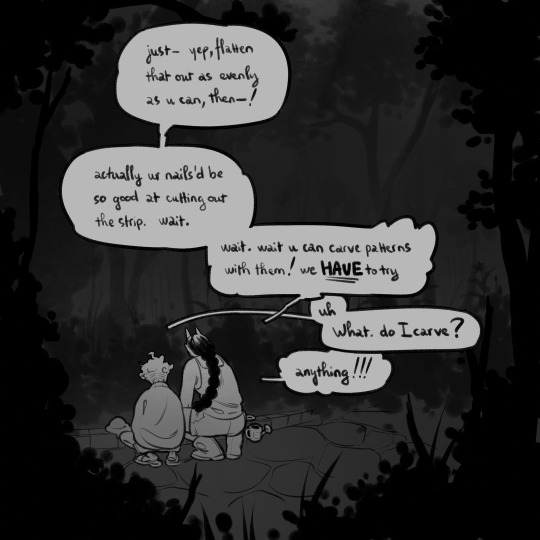

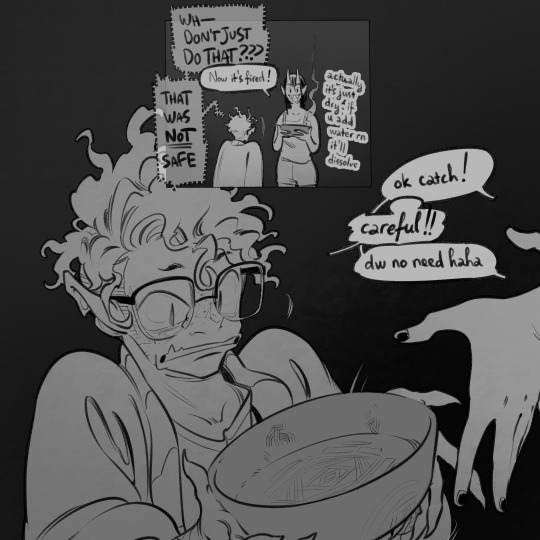


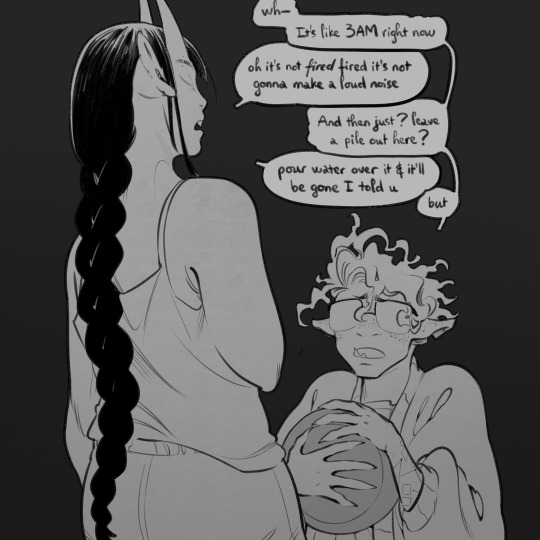

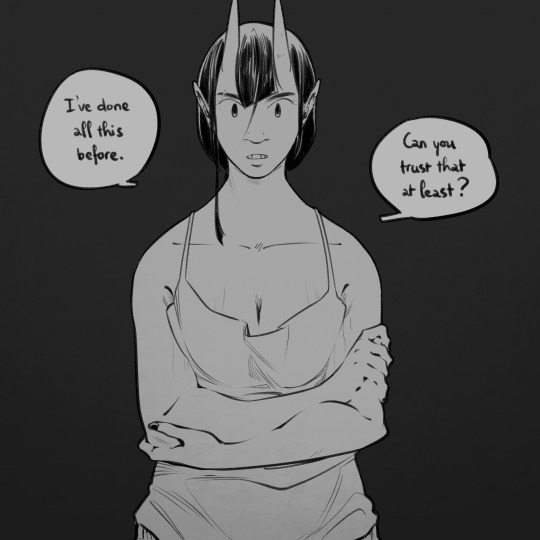
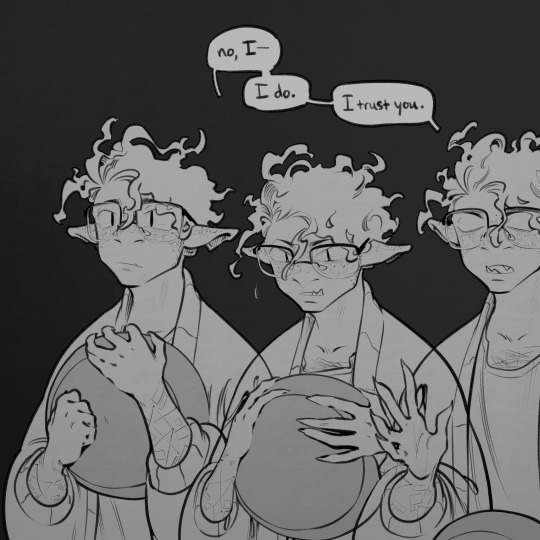
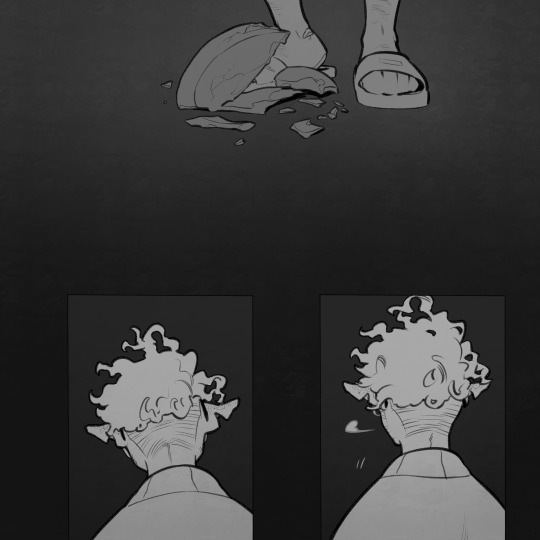
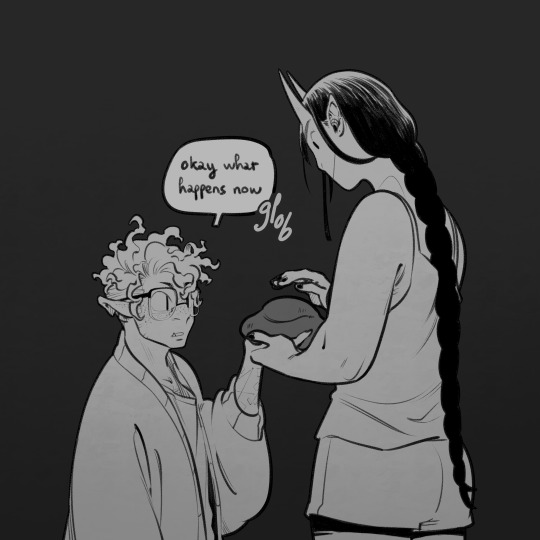
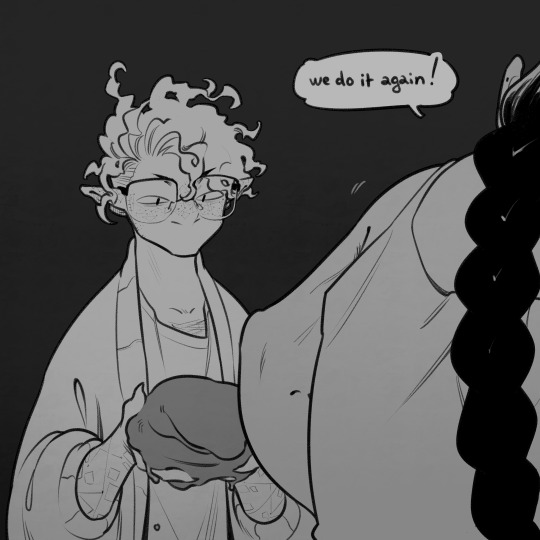
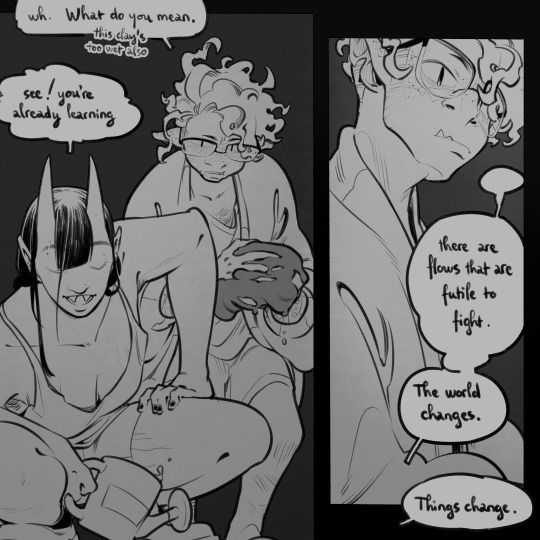
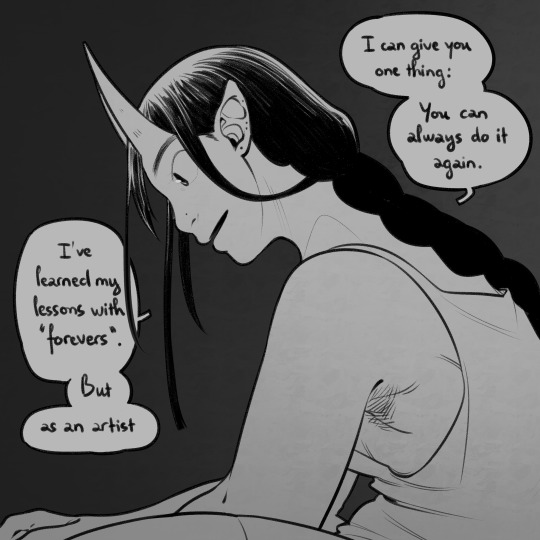


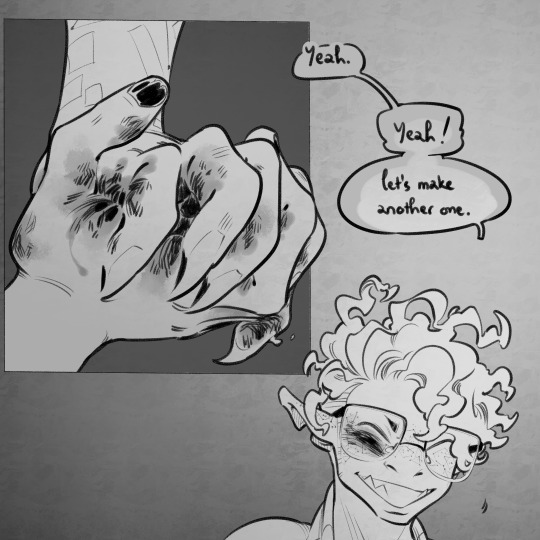
soon it'll be dawn again
transcript under the cut ⏬
page 01
Fig: no way? - you're still up?
Riz: Wh– yes?
Riz: Why'd I not be.
page 02
Fig: I me~~ean - that took.
Fig: whole day.
Riz: Yeah?
Fig: 'm beat.
Riz: you should sleep.
page 03
Fig: nah. my guy's still up
Fig: I wanna hang out.
page 04
Riz: That's really nice.
Fig: Hah! - Nobody ever expects an Archdevil rockstar to be nice.
Riz: … yeah. - 's just budget work tho. (the stuff I'm working on) - I've heard it's boring.
page 05
Fig: yeah, but you do it…
Riz: It keeps things going, right? - Nothing happens if nobody sits down and - does the thing.
Fig: That's right… - though. Yeah.
page 06
Fig: sometimes it's someone else who - doesn't want the same thing to happen.
Riz: … - mm.
page 07
Riz (off screen): …It took me a long time to get that not everyone likes doing what I do. - 's probably because you guys are so nice– - or. - kind.
Riz (off screen): to anyone too, not just. - the people you /love/.
page 08
Riz: that's not how it is elsewhere. - The world's– not. hostile. - but 's not like it's kind.
Riz: So I'm doing as much as I can now…
page 09
Fig: Hey.
Riz: ?
Fig: Go dig some dirt with me.
page 10
Riz: [blank speech bubble] - oh you meant like - actual dirt. (not incriminating information)
Fig: o yea.
Fig: there's clay in the backyard soil. - sometimes when I'm sun deficient or something I go touch dirt for a bit.
page 11
Fig: here u go
page 12
Riz: uh
Fig: now we make a thing! - 'm pretty good at freehanding a bowl.
Fig: I'll show u
page 13
Fig: just– yep, flatten that out as evenly as u can, then–! - actually ur nails'd be so good at cutting out the strip. [larger than usual space] wait. - wait. wait u can carve patterns with them! we HAVE to try
Riz: uh - What. do I carve?
Fig: anything!!!
page 14
Fig: and– yep just seal the inside uh. seam?
Fig: yep that works - okay time's up! all contestant hands up
Riz: [blank speech bubble] - okay - wh. what's next?
Fig: haha - watch this.
(sound effect text): FWOO—MP
page 15
Riz: WH– DON'T JUST DO THAT???
Fig: Now it's fired!
Riz: THAT WAS NOT SAFE
Fig: (actually it's just dry. if u add water rn it'll dissolve)
Fig: ok catch!
Riz: [blank speech bubble] - careful!!
Fig: dw no need haha
page 16
Riz (thought bubble): oh - it's warm…
Fig: now I want you to throw this.
page 17
Fig: u gotta do it - c'mon
page 18
Riz: wh– - It's like 3AM right now
Fig: oh it's not /fired/ fired it's not gonna make a loud noise
Riz: And then just? leave a pile out here?
Fig: pour water over it & it'll be gone I told u
Riz: but
page 19
Fig (off screen): RIz.
page 20
Fig: I've done all this before.
Fig: Can you trust that at least?
page 21
Riz: no, I– - I do. - I trust you.
page 23
Riz: okay what happens now
(sound effect text): glob
page 24
Fig: we do it again!
page 25
Riz: wh. [larger than usual space] What do you mean. (this clay's too wet also)
Fig: see! you're already learning
Fig: [blank speech bubble] - there are flows that are futile to fight. - The world changes.
Fig: Things change.
page 26
Fig: I've learned my lessons with "forevers". - But - as an artist
Fig: I can give you one thing: - You can always do it again.
page 27
Fig: most of everything depends on the rest of the world, - but this. - making new. - that's yours as long as you want it.
page 28
Fig: So?
page 29
Riz: Yeah. - Yeah! - let's make another one.
#dimension 20#fantasy high junior year#fhjy#riz gukgak#figueroth faeth#technically no spoilers in this comic but listen. I Will be gloating in tags. I will Never Shut Up#for the record!! this was fully conceptualized and sketched Before the finales. I started sketching this after the boat fight#and when murph closed riz's arc this season with ''maybe it's okay to change and welcome new things'' I pogged irl#I am simply the best at reading comprehension what can I say! (<- grown ass man with roughly the same perspective on teenhood as the player#fucked up that this became so long (almost 30 squares lol) that it took me this long to finish#lmao I say all that but. genuinely I am delirious and my feelings abt riz's arc this season are so big... I was getting psychic backlash#for a While lol. it was scary!!#had to sit down and do therapy on my own ass for a bit. the teenage apocalyticisation is real. that word isnt tho Im pretty sure#truly anything you do at that age feels like that's it that's all you've got going on forever. and its not true! its simply not true#you'll be okay my guy. you love your friends so so much but also there will be more to love out there#this one goes out to fellow aroaces and also folks leaving somewhere theyve called home for a long time#nothing lasts forever but that means new things come by too! ur ability to make new is infinite!!#there's no magnum opus people leave but new people come by too etc. I am too sleepy to remember what I wanted to say uhhh#well. thank u for looking at my art. I think thats the one pack it n ship it boys
2K notes
·
View notes
Text

work in progress
#the owl house#hunter toh#emperor belos#work in progress#digital illustration#horror art#i drew hunter happy so now i have to draw him experiencing the horrors#balanced as all things should be#also thank u guys for reblogging my older hunter art ur tags r making my day !!#low key don’t want to color this even tho i should#i love the line art too much
368 notes
·
View notes
Text



And he had great influence, both from the favours which he bestowed and the fear which he inspired, but more from the fear. At any rate, Sicinnius, who gave the greatest annoyance to the magistrates and popular leaders of his day, when asked why Crassus was the only one whom he let alone and did not worry, said that the man had hay on his horn. Now the Romans used to coil hay about the horn of an ox that gored, so that those who encountered it might be on their guard.
-Plutarch, Crassus 7
#roman republic tag#drawing tag#komiks tag#i have been doing so much reading about the sforzas (it's about ascanio it's always about ascanio except for when it's about#one of the other maria sforzas but usually it's about ascanio) that i briefly forgot about rome entirely#sort of. byzantium ofc occupies a permanent residence somewhere in my memory cache thanks to. valens#unpeeled some new thoughts about crassus while doing other stuff tho so i'll have to shake those violently in a box for a bit#and see what shakes loose
197 notes
·
View notes